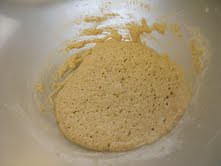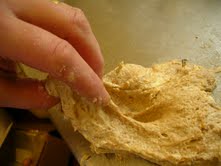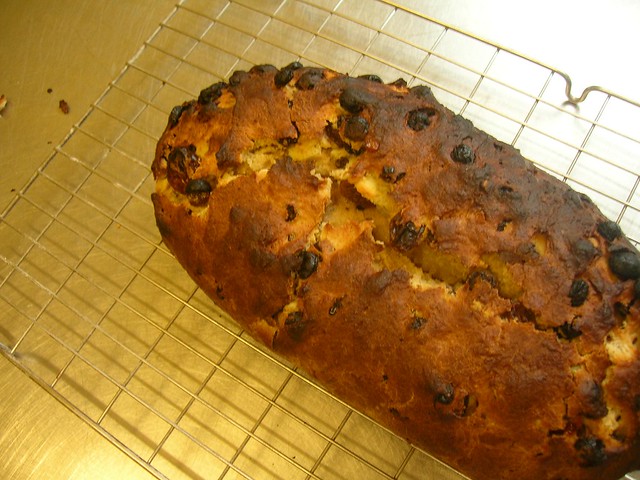I love getting tried and tested recipes and was particularly delighted to receive this stollen cake recipe from an experienced baker – Chis from At Lane Bakery – whose heart is firmly in good quality baking. Here he tells his own story…..
Cat Lane Bakery
Cat Lane Bakery is housed in a small, rather scruffy building behind a row of houses, in a largely residential area of Sheffield. The original baker’s shop was opened in 1906 by Mrs Garner and the bakery was built in the 1930’s as her business developed. Nowadays the bakery is run by Sheffield Wholefoods Ltd, a workers’ co-operative, and most of the bread produced is sold through our award-winning shop, Beanies, in Crookes in Sheffield.
Chris Baldwin, a co-op member, and currently the bakery manager says:
“We were searching around for a supplier of good, real bread in Sheffield and couldn’t find one – so when the bakery building became available we decided the only way was to make our own. It’s been a sharp learning curve as none of us have had professional baking experience, but with a lot of support from our miller, Mervin Austin at the Mount Pleasant Windmill in Lincolnshire, and through contact with the Real Bread Campaign – we are now in a position to offer real, organic bread to outlets throughout South Yorkshire and parts of Derbyshire.”
What is Real Bread?
Real Bread is bread made with the simplest of ingredients using traditional techniques. Cat Lane bakers use organic flour, water salt and yeast as the basis for our breads. We don’t use flour improvers or preservatives but allow time to do the work – long, slow fermentation allows the bread to develop great flavour and also enhances the keeping quality.
The resulting breads are tasty and nutritious with great textures and flavours.
Stollen – A Christmas treat
At Cat Lane bakery the aim is to keep seasonal products seasonal! Hot Cross Buns appear only in the run up to Easter; Mince pies and Stollen are Christmas treats. The Stollen in particular is a firm favourite with our customers. The recipe is based on that offered by Andrew Whitley in ‘Bread Matters’ but I have changed one or two weights so that it is possible to actually handle the dough! It’s not difficult to make but can seem a little bit faffy with several different elements to prepare, and the dough is very loose and sticky – try to avoid the temptation to add extra flour as this can make the finished bread a bit heavy
Tip – for ease of handling dip your hands in a little four and dust off the excess.
The following recipe makes one largeish Stollen.
The Day Before Baking Day
1. Make your Almond Paste
It is possible to use commercial marzipan for this recipe but I find it is too smooth in texture and a little synthetic in flavour so I tend to make my own. This almond paste uses two types of sugar. This is not essential but icing sugar on its own is too smooth while caster sugar alone can be too gritty. If you only have one type then best use caster sugar. Similarly with the nuts – commercially ground almonds can be too fine. Ideally pop some whole almonds with their skins still on, into a coffee grinder and whiz them so that there are still some fragments in the mix.
You will need:-
160g Freshly ground almonds
20g Caster Sugar
20g Icing Sugar
50g Egg, beaten (1 medium egg)
- Combine the ingredients in a bowl and stir until fully incorporated
- Form the paste into a ball
- Wrap in cling-film or pop it in a plastic bag and put it in the fridge to harden up
– this will make it easier to handle when the time comes.
2. Pre-soak the dried fruit
70g Sultanas
60g Raisins
50g Mixed peel
2 tbsp Brandy
- Put the dried fruit in a plastic bag and add the brandy
- Tie the bag closed and shake the fruit and brandy together
- Leave overnight or set aside for at least a couple of hours
Brandy is optional, of course – you could use Rum or sherry or you can soak the fruit in a drop of fruit juice, Earl Grey tea or just plain water.
Baking day
1. Start a Pre-ferment
A pre-ferment, or sponge, allows the yeast to become active and lively before adding ingredients such as butter and sugar which can have an inhibiting effect. I prefer to use fresh yeast but dried is fine too – if using dried use half the quantity and dissolve it in the milk before adding the flour.5g Sugar
10g Yeast
60g Milk
50g Strong Wholemeal Flour
- Cream the yeast, sugar and milk together then add the flour
- Cover and set aside in a warm place for an hour or so
- As the yeast starts to work the mixture will become bubbly and fluffy
2. Mixing the main dough
When the ferment is ready, it is time to mix the dough:
170g Strong White flour
40g Strong wholemeal flour
30g Caster Sugar
5g Salt
1 medium egg
- Place the dry ingredients in a bowl and mix together
- Add the pre-ferment and the egg
- Mix all the ingredients together and then tip this sloppy dough out onto the worktop and knead
- The dough should be quite loose and sticky in your fingers
- If it feels too firm add a drop more milk but avoid adding flour if it’s sticky
- if it’s just too sticky to handle then let it rest in its bowl for half an hour before you try to knead it
(For useful tips and a demonstration of kneading a very wet dough, view this video
Owing to the higher wholemeal content in this recipe you certainly don’t need to knead for 20 minutes as suggested in the video! 5 – 10 mins should be plenty.) (Please also note it is quite difficult to take photos of one hand when they are both covered in sticky
dough!)
- When you’ve finished kneading, place the dough in an oiled bowl and cover the bowl with a damp tea-towel
- Leave in a warm draught free place for an hour or so to prove
- The dough could have doubled in size
- Tip it out onto the worktop again and spread it slightly
(– although how you are meant to know that it is actually double in size I’m not sure! – it will look a bit bigger though and feel springy to the touch…)
then add
50g Butter or margarine
- Work the fat into the dough, folding it in and kneading until it is fully incorporated
- Now add the soaked dried fruit and fold this gently into the dough to taking care not to crush the fruit
- Now place the dough back in its bowl for about 20 minutes or so to rest
– otherwise it will turn into a rather unsightly mush.
3. Shaping the Stollen
At this stage it’s a good idea to turn your oven on to heat up. Set it to about 400F or 200C.
- Place the dough onto the worktop and gently ease it into a flat round shape about 20cm or 8” in diameter
- Use a floured rolling pin if you prefer but again take care not to crush the fruit
- Take the ball of almond paste and press or roll this out to be slightly smaller than the dough
- Place the almond paste on top of the dough and fold the furthest edge over into the middle
- Then fold the nearer edge over the top of that
- Tuck in the ends to tidy the roll and flip it over onto its seam
- Place on a baking tray, cover and set this aside for a final rise of about an hour
– with so many heavy ingredients incorporated you cannot expect it to rise very much but the dough will feel springy to the touch.
4. Baking
- Pop the Stollen into the preheated oven for about 30-35 minutes
Knowing when the Stollen is cooked can be a little challenging as it doesn’t echo when tapped as normal loaves do, owing to the almond paste in the middle. If you have a probe thermometer you can check that the internal temperature is between 90 and 100C. It should be a golden brown on top although it is quite easy to allow the colour to darken owing to the sugar content of the dough. Don’t worry about this just brush it with melted butter (or margarine) and dust generously with icing sugar – no-one will notice. If you notice before it’s too late you can cover the bread in the oven with a piece of baking parchment.
Take care handling the cooked dough as it is prone to breaking while warm.
They do say that, wrapped up in foil and kept in a cool dry place, Stollen will keep for several weeks – but my children have never allowed that to happen!
Season’s Greetings!
Chris Baldwin





Stollen cake is one of my seasonal favorites.